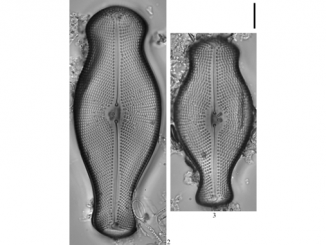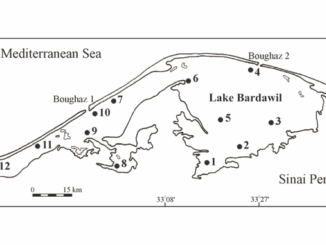
Paper category: Original research paper
Corresponding author: Jarosław Kur (jarek.kur@gmail.com)
DOI: 10.1515/ohs-2020-0023
Received: 09/10/2019
Accepted: 30/01/2020
Full text: here
Citation (APA style): Oceanological and Hydrobiological Studies, Volume 49, Issue 3, Pages 255–266, eISSN 1897-3191, ISSN 1730-413X, DOI: https://doi.org/10.1515/ohs-2020-0023.
Abstract
The majority of Polish studies on freshwater cyclopoids focused on surface water fauna. There are relatively few data on copepods of subterranean waters. Thus, in our research, copepods were collected from 37 different, mostly groundwater-dependent habitats (i.e. caves, springs, wells, interstitial and overhead environments) over a period of five years between 2005 and 2010. A total of 22 species belonging to eight genera were found. Some species, previously not recorded or known only from a few sites in Poland, proved to be a frequent component of subterranean communities.
References
Alekseev, V., Dumont, H. & Pensaert, J. (2006). A redescription of Eucyclops serrulatus (Fischer, 1851) (Crustacea: Copepoda: Cyclopoida) and some related taxa, with a phylogeny of the E. Serrulatus-group. Zoologica Scripta 35(2): 123–147. DOI: 10.1111/j.1463-6409.2006.00223.x.
Bajkiewicz-Grabowska, E. (2001). Zasoby wodne, gospodarka wodna. Elektroniczny atlas środowiska Polski: Centrum Informacji o Środowisku. UNEP/GRID Warszawa. (In Polish).
Berger, I. & Maier, G. (2001). The mating and reproductive biology of the freshwater planktonic calanoid copepod Eudiaptomus gracilis: Freshwater Biology 46(6): 787–794. DOI: 10.1046/j.1365-2427.2001.00717.x.
Bláha, M., Huluk, M., Sloukov, J. & Těšitel, J. (2010). Molecular and morphological patterns across Acanthocyclops vernalis-robustus species complex (Copepoda, Cyclopoida). Zoologica Scripta 39: 259–268. DOI: 10.1111/j.1463-6409.2010.00422.x.
Błędzki, L.A. & Rybak, J.I. (2016). Freshwater Crustacean Zooplankton of Europe Cladocera & Copepoda (Calanoida, Cyclopoida) Key to species identification, with notes on ecology, distribution, methods and introduction to data analysis. Springer International Publishing XV, 918. DOI: 10.1007/978-3-319-29871-9_11.
Botosaneanu, L. & Holsinger, J.R. (1991). Some aspects concerning colonization of the subterranean realm – especially of subterranean waters: a response to Rouch and Danielopol: Stygologia 6(1): 11–39.
Brancelj, A., Boonyanusith, C., Watiroyram, S. & Sanoamuang, L. (2013) .The groundwater-dwelling fauna of Southeast Asia. J. Limol. 72(2): 327–344. DOI: 10.4081/jlimnol.2013.s2.e16.
Chodorowska, W. & Chodorowski, A. (1960). Ugrupowania fauny wodnej w jaskiniach tatrzańskich. Speleologia II 1: 57–62. (In Polish).
Clarke, K.R. & Gorley, R.N. (2005). PRIMER v7: User Manual/Tutorial: PRIMER-E, Plymouth. Colwell, R.K, Chao, A. & Gotelli, N.J. (2012). Models and estimators linking individual-based and sample-based rarefaction, extrapolation, and comparison of assemblages. Journal of Plant Ecology 5: 21. DOI:10.1093/jpe/rtr044.
Culver, D.C. & Sket, B. (2000). Hotspots of Subterranean Biodiversity in Caves and Wells. Journal of Cave and Karst Studies 62(1): 11–17.
de Jong, Y., Verbeek, M., Michelsen, V. Bjørn, P., Los, W. et al. (2014). Fauna Europaea – all European animal species on the web. Biodiversity Data Journal 2: e4034.
Dumnicka, E. & Galas, J. (2017). An overview of stygobiontic invertebrates of Poland based on published data. Subterranean Biology 23: 1–18. DOI: 10.3897/subtbiol.23.11877.
Dumnicka, E. & Skalski, A. (1999). Fauna podziemna Tatr, Jaskinie Tatrzańskiego Parku Narodowego 7. Wyd. PTPNoZ 13–33. (In Polish).
Dumnicka, E. & Wojtan, K. (1990). Differences between cave water ecological systems in the Kraków-Częstochowa Upland. Stygologia 5: 241–247.
Dussart, B.H. & Defaye, D. (2001). Introduction to the Copepoda: In Dumont H.J. (Ed.) Guides to the Identification of the Microinvertebrates of the Continental Waters of the World 16. Backhuys Publishers, Leiden. DOI: 10.1127/archiv-hydrobiol/152/2001/703.
Dürbaum, J. & Künnemann, T. (2010). Biology of Copepods: An Introduction. Carl von Ossietzky University of Oldenburg July 12, 2010 //www.uni-oldenburg.de/zoomorphology/Biologyintro. 2000.
Einsle, U. (1992). Nordamerikanische Arten der Gattungen Eucyclops und Acanthocyclops (Crustacea, Copepoda) aus alten Proben der Sammlung F. Kiefer. Andrias 9: 195–210. (In German).
Einsle, U. (1996). Copepoda: Cyclopoida. Guides to the Identification of the Microinvertebrates of the Continental Waters of the World. Genera Cyclops, Megacyclops, Acanthocyclops: Belgium, State University of Gent 83. DOI: 10.1127/archiv-hydrobiol/152/2001/703.
Galassi, D., De Laurentiis, P. & Petitta, M. (2001). Influenza dei fattori storici ed ecologici sulla biodiversita animale: la copepodofauna (Crustacea: Copepoda) delle sorgenti di Presciano (Fiume Tirino, L’Aquila, Abruzzo). Monitoraggio Biologico del Gran Sasso 2: 160–182. (In Italian).
Galassi, D., Marmonier, P., Dole-Olivier, M.J. & Rundle, S. (2002). Microcrustacea. Freshwater Meiofauna: Biology and Ecology. Backhuys Publishers, Leiden 135–175.
Garden, E. (1923). Zur Kenntins der Harpacticidenfauna Deutschlands. Zool. Anz., Leipzig 57: 61–68. (In German).
Garden, E. (1924). Beitage zur Copepodenkunde Deutshchland. Zool. Anz., Leipzig 60: 334–336. (In German).
Glazier, D. & Sparks, B. (1997). Energetics of amphipods in ion-poor waters: stress resistance is not invariably linked to low metabolic rates. Functional Ecology 11: 126–128.
Gliwicz, M. & Rowan, M. (1984). Survival of Cyclops abyssorum tatricus (Copepoda, Crustacea). Limnology and Oceanography 29: 1290–l299. DOI: 10.4319/lo.1984.29.6.1290.
Gutkowska, A., Paturej, E. & Kowalska, E. (2012). Qualitative and quantitative methods for sampling zooplankton in shallow coastal estuaries. Ecohydrology & Hydrology 12: 253–263. DOI: 10.1016/s1642-3593(12)70208-2.
Haffer, J. (1969). Speciation in Amazonian forest birds. Science 165: 131–137. DOI: 10.1126/science.165.3889.131.
Herr, O. (1921). Hydrobiologishe Beobachtungen aus dem Riesengebirge Zool Anz Leipzig 53: 12–16. DOI: 10.1002/asna.19212151105. (In German).
Hewitt, G.M. (2001). Speciation, hybrid zones and phylogeography – or seeing genes in space and time: Molecular Ecology 10: 537–549. DOI: 10.1046/j.1365-294x.2001.01202.x.
Hołyńska, M. (2008). Cyclopoida. In W. Bogdanowicz, E. Chudzicka, I. Pilipiuk & E. Skibińska (Eds.), Fauna of Poland – characteristics and checklist of species (pp. 301–304, 311). Muzeum i Instytut Zoologii PAN, Warszawa, 3, 603.
Hołyńska, M. & Dimante-Deimantovica, I. (2016). Redescription and taxonomic notes on Cyclops bohater Koźmiński, 1933 and Cyclops lacustris G.O. Sars, 1863 (Arthropoda, Crustacea), with an identification key to the Cyclops species of Fenno-Scandinavia. European Journal of Taxonomy 212: 1–31.
Hołyńska, M. & Wyngaard, G.A. (2019). Towards a phylogeny of Cyclops (Copepoda): (in)congruences among morphology, molecules and zoogeography. Zoologica Scripta 48: 376–398.
Iepure, S. & Defaye, D. (2008). The Acanthocyclops kieferi Complex (Copepoda, Cyclopoida) from South-Eastern Europe, with Description of a New Species. Crustaceana 81: 611–630. DOI: 10.1163/156854008784092210.
Iepure, S. & Oarga, A. (2011). A new Acanthocyclops Kiefer, 1927 (Copepoda: Cyclopidae) from
caves in Apuseni Mountains (north-western Romania). Annales Zoologici 61(2): 427–438.
Jaccard, P. (1912). The distribution of the flora in the alpine zone. New Phytologist 11: 37–50. DOI: 10.1111/j.1469-8137.1912.tb05611.x.
Jancewicz, E. & Falkowska E. (2017). Glacial refugia in Europe: what do we know about the history of contemporary plant and animal species. Sylwan 161(12): 982−990.
Kiefer, F. (1960). Ruderfusskrebse (Copepoden). Einfϋhrung in die Kleinlebewelt Kosmos-Verlag, Franckh, Stuttgart 1–97. (In German). DOI: 10.1002/iroh.19640490321.
Kondracki, J. (2002). Geografia regionalna Polski. PWN, Warszawa. DOI: 10.2307/1793481. (In Polish).
Koźmiński, Z. (1933). Badania morfometryczne i ekologiczne nad oczlikami (cyclopidae) z grupy strenuus. Morphometric and ecological studies on cyclopids from the strenuus group. Archiwum Hydrobiologii i Rybactwa 7: 59−140. (In Polish).
Kur, J. (2012). Zmienność populacyjna widłonogów Copepoda w wodach podziemnych Południowej Polski Unpublished doctoral dissertation, IOP, 127 pp. (In Polish).
Kur, J. & Wojtasik, B. (2007). Widłonogi Cyclopoida wybranych jezior zlewni górnej Raduni. Jeziora Kaszubskiego Parku Krajobrazowego 145–163. (In Polish).
Kur, J., Radwański, J.M. & Mioduchowska, M. (2016). Investigation of the fauna in the Szmaragdowa/Szeptunów Cave in Poland: an example of short time colonization process. Acta Zoologica Cracoviensia 59(2): 153–162. DOI: 10.3409/azc.59_2.153.
Lindner, L. (2005). Nowe spojrzenie na liczbę, wiek i zasięgi zlodowaceń środkowopolskich w południowej części środkowowschodniej Polski. Przegląd Geologiczny 53(2): 145–150. (In Polish).
Mioduchowska, M. & Wojtasik, B. (2009). Copepoda-Cyclopoida of water bodies of the coast of Gdańsk. Teka Kom. Ochr. Kszt. Środ .Przyr. – OL PAN 6: 189–199.
Mirabdullayev, I.M. & Kuzmetov, A.R. (1998). The genus Thermocyclops (Crustacea: Copepoda) in Uzbekistan (Central Asia). Internationale Revue Der Gesamten Hydrobiologie 82(2): 201–212. DOI: 10.1002/iroh.19970820207.
Namiotko, T. (1990). Freshwater Ostracoda (Crustacea) of Żuławy Wiślane (Vistula Fen Country, Northern Poland). Acta Zoologica Cracoviensia 33(19): 459–484.
Pesce, G. (1992). Cyclopids from ground waters of Turkey, and description of Diacyclops languidoides anatolicus n. spp. (Crustacea, Copepoda). Fragm. Entomol. Roma 24(1): 1–12.
Pesce, G.L. & Galassi, P.D. (1984). Acanthocyclops kieferi kieferi (Chappius) Di acque freatiche delle Toscana: Cyclopoide nuovo per la fauna Italiana (Crustacea Copepoda: Cyclopinae) Contributo alla conoscenza della fauna delle acque sotterranee delle Italia centro- meridionale. XXXVI. Riv. Idrobiol. Perugia 23(2–3): 159–164. (In Italian).
Pipan, T. (2005). Epikarst – A promising Habitat: copepod fauna, its diversity and ecology : a case study from Slovenia (Europe). Karst Research Institute at ZRC SAZU, ZRC Publishing, Ljubljana, Slovenia.
Pipan, T. & Brancelj, A. (2004). Distribution Patterns of Copepods (Crustacea: Copepoda) in Percolation Water of the Postojnska Jama Cave System (Slovenia). Zoological Studies 43(2): 06–210.
Por, F.D. & Dimentman, C. (2001). Cyclopoid diversity in the basin of Lake Hula (Israel) after its partial reflooding. Hydrobiologia 453/454: 335–339. DOI: 10.1007/0-306-47537-5_27.
Pospisil, P. & Stoch, F. (1999). Two new species of the Diacyclops languidoides – group (Copepoda, Cyclopida) from ground waters of Austria: Hydrobiologia 41: 165–176.
Prószyńska, M. (1963). Les Copepoda Calanoida des grottes des montagnes Tatras. Actes Ile Congr Int Speleol, Italia 2: 73. (In Italian).
Pulina, M. (1997). Karst areas in Poland and their changes by human impact. Landform Analysis 1: 55–71.
Razowski, J. (1997). Wykaz zwierząt Polski T. IV. Kraków: Instytut Systematyki i Ewolucji Zwierząt PAN, 303. (In Polish).
Rull, V. (2009). Microrefugia. Journal of Biogeography 36: 481−484. DOI: 10.1111/j.1365-2699.2008.02023.
Rybak, J.I. & Błędzki, L.A. (2005). Widłonogi, Copepoda: Cyclopoida, Klucz do oznaczania. Biblioteka Monitoringu Środowiska, Inspekcja Ochrony Środowiska, Warszawa. (In Polish).
Schäfer, H.W. (1936). Harpacticoiden aus dem Brackwasser der Insel Hiddensee. Mitt. naturw. Ver. Neu-Vorpomm. Rugen 63: 16−19. (In German).
Schmitt, T. & Varga, Z. (2012). Extra-Mediterranean refugia: the rule and not the exception? Frontiers in Zoology 9: 22. DOI: 10.1186/1742-9994-9-22.
Stoch, F. (1995). The ecological and historical determinants of crustacean diversity in groundwaters, or: why are there so many species? Mémories Biospéologie 22: 139–160.
Stoch, F. (1998). Moraria alpina n. sp. and redescription of Moraria radovnae Brancelj 1988, new rank, from Italian and Slovenian Alps (Crustacea, Copepoda, Harpacticoida). Studi Trentini di Scienze Naturali. Acta Biologica 73: 135–145.
Stoch, F. (2000). Indagini sulla fauna acquatica delle grotte del Trentino (Italia settentrionale). Studi Trentini di Scienze Naturali. Acta Biologica 74: 117−132. (In Italian).
Stoch, F. (2001). How many species of Diacyclops? New taxonomic characters and species richness in a freshwater cyclopid genus (Copepoda, Cyclopoida). Hydrobiologia 453/454: 525–531. DOI: 10.1007/0-306-47537-5_45.
Stoch, F. (2003). Indagini ecologiche e faunistiche sulla meiofauna (Acari e Crostacei) di alcune sorgenti del Parco Naturale delle Prealpi Giulie (Italia nord-orientale). Gortania, Atti Museo Friulano di Storia Naturale di Udine 25: 239–250. (In Italian).
Ślusarczyk, A. (2003). Limnological study of a lake formed in limestone quarry (Kraków, Poland). I. Zooplankton community. Pol. J. Envir. Studies 12: 495–499.
Tabacki, A. (1971). Widłonogi (Copepoda) rzeki Grabi Zeszyty Naukowe UŁ. Nauki Mat.-Przyr. II 44: 31–52. (In Polish).
Tabacki, A. (1980). Widłonogi (Copepoda) wód studziennych okolic Sulejowa koło Łodzi. Acta Univ Lodz Zeszyty Naukowe UŁ, Nauki Mat.-Przyr. II 33: 123–128. (In Polish).
Tomaszewski, W. (1932). Beitrag zur Kenntins der Tierwelt Schlesischer Bergbache Abh. Ges. Gorlitz 31: 1–8. (In German).
Wróblewski, A. & Sywula, T. (1997). Copepoda-Widłonogi. In J. Razowski (Ed.), Wykaz zwierząt Polski T. IV: 158–164. (In Polish).




Bądź pierwszy, który skomentuje ten wpis